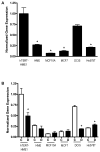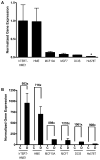Comparative regulation of gene expression by 1,25-dihydroxyvitamin D3 in cells derived from normal mammary tissue and breast cancer
- PMID: 25239595
- PMCID: PMC4760099
- DOI: 10.1016/j.jsbmb.2014.09.014
Comparative regulation of gene expression by 1,25-dihydroxyvitamin D3 in cells derived from normal mammary tissue and breast cancer
Abstract
Previous genomic profiling of immortalized, non-tumorigenic human breast epithelial cells identified a set of 1,25-dihydroxyvitamin D3 (1,25D) regulated genes with potential relevance to breast cancer prevention. In this report, we characterized the effect of 1,25D on a subset of these genes in six cell lines derived from mammary tissue and breast cancers. Non-tumorigenic cell lines included hTERT-HME1, HME and MCF10A cells which are often used to model normal breast epithelial cells. Breast cancer cell lines included MCF7 cells (a model of early stage, estrogen-dependent disease), DCIS.com cells (a derivative of MCF10A cells that models in situ breast cancer) and Hs578T cells (a model of metastatic disease). All of these cell lines express the vitamin D receptor (VDR) and exhibit anti-cancer responses to 1,25D such as changes in proliferation, apoptosis, metabolism, or invasion. Our comparative data demonstrate highly variable responses to 1,25D (100nM, 24h) between the cell lines. In both hTERT-HME1 and HME cell lines, CYP24A1, SLC1A1 and ITGB3 were up-regulated whereas KDR, GLUL and BIRC3 were down-regulated in response to 1,25D. In contrast, no changes in SLC1A1, ITGB3 or GLUL expression were detected in 1,25D treated MCF10A cells although KDR and BIRC3 were down-regulated by 1,25D. The effects of 1,25D on these genes in the breast cancer cell lines were blunted, with the DCIS.com cells exhibiting the most similar responses to the immortalized hTERT-HME1 and HME cells. The differences in cellular responses were not due to general impairment in VDR function as robust CYP24A1 induction was observed in all cell lines. Thus, our data indicate that the genomic changes induced by 1,25D are highly cell-type specific even in model cell lines derived from the same tissue. The implication of these findings is that genomic responses to changes in vitamin D status in vivo are likely to be distinct from individual to individual, particularly in neoplastic tissue. This article is part of a Special Issue entitled '17th Vitamin D Workshop'.
Keywords: Genomics; Mammary gland; Vitamin D.
Copyright © 2014 Elsevier Ltd. All rights reserved.
Figures


Similar articles
-
Gene Signatures of 1,25-Dihydroxyvitamin D3 Exposure in Normal and Transformed Mammary Cells.J Cell Biochem. 2015 Aug;116(8):1693-711. doi: 10.1002/jcb.25129. J Cell Biochem. 2015. PMID: 25736056 Free PMC article.
-
Modeling vitamin D actions in triple negative/basal-like breast cancer.J Steroid Biochem Mol Biol. 2014 Oct;144 Pt A:65-73. doi: 10.1016/j.jsbmb.2013.10.022. Epub 2013 Nov 14. J Steroid Biochem Mol Biol. 2014. PMID: 24239860 Free PMC article. Review.
-
Differences in transcriptional effects of 1α,25 dihydroxyvitamin D3 on fibroblasts associated to breast carcinomas and from paired normal breast tissues.J Steroid Biochem Mol Biol. 2013 Jan;133:12-24. doi: 10.1016/j.jsbmb.2012.08.002. Epub 2012 Aug 23. J Steroid Biochem Mol Biol. 2013. PMID: 22939885
-
Identification of vitamin D3 target genes in human breast cancer tissue.J Steroid Biochem Mol Biol. 2016 Nov;164:90-97. doi: 10.1016/j.jsbmb.2015.10.012. Epub 2015 Oct 17. J Steroid Biochem Mol Biol. 2016. PMID: 26485663
-
Genomic vitamin D signaling in breast cancer: Insights from animal models and human cells.J Steroid Biochem Mol Biol. 2010 Jul;121(1-2):362-7. doi: 10.1016/j.jsbmb.2010.03.061. Epub 2010 Apr 20. J Steroid Biochem Mol Biol. 2010. PMID: 20412854 Free PMC article. Review.
Cited by
-
PADI2 gene confers susceptibility to breast cancer and plays tumorigenic role via ACSL4, BINC3 and CA9 signaling.Cancer Cell Int. 2016 Jul 29;16:61. doi: 10.1186/s12935-016-0335-0. eCollection 2016. Cancer Cell Int. 2016. PMID: 27478411 Free PMC article.
-
Evaluation of Serum Vitamin D Levels in Adolescents with Pubertal Gynecomastia.Breast Care (Basel). 2016 Oct;11(5):333-337. doi: 10.1159/000451074. Epub 2016 Oct 13. Breast Care (Basel). 2016. PMID: 27920626 Free PMC article.
-
1,25-Dihydroxyvitamin D Regulation of Glutamine Synthetase and Glutamine Metabolism in Human Mammary Epithelial Cells.Endocrinology. 2017 Dec 1;158(12):4174-4188. doi: 10.1210/en.2017-00238. Endocrinology. 2017. PMID: 29029014 Free PMC article.
-
PTH and Vitamin D.Compr Physiol. 2016 Mar 15;6(2):561-601. doi: 10.1002/cphy.c140071. Compr Physiol. 2016. PMID: 27065162 Free PMC article. Review.
-
Diagnostic Aspects of Vitamin D: Clinical Utility of Vitamin D Metabolite Profiling.JBMR Plus. 2021 Dec 3;5(12):e10581. doi: 10.1002/jbm4.10581. eCollection 2021 Dec. JBMR Plus. 2021. PMID: 34950834 Free PMC article. Review.
References
-
- Lazzaro G, Agadir A, Qing W, Poria M, Mehta RR, Moriarty RM, et al. Induction of differentiation by 1alpha-hydroxyvitamin D(5) in T47D human breast cancer cells and its interaction with vitamin D receptors. European Journal of Cancer. 2000;36(6):780–6. - PubMed
-
- Mathiasen IS, Sergeev IN, Bastholm L, Elling F, Norman AW, Jaattela M. Calcium and calpain as key mediators of apoptosis-like death induced by vitamin D compounds in breast cancer cells. J Biol Chem. 2002;277(34):30738–45. - PubMed
-
- Narvaez CJ, Welsh J. Role of mitochondria and caspases in vitamin D-mediated apoptosis of MCF-7 breast cancer cells. The Journal of Biological Chemistry. 2001;276(12):9101–7. - PubMed
-
- Swami S, Raghavachari N, Muller UR, Bao YP, Feldman D. Vitamin D growth inhibition of breast cancer cells: gene expression patterns assessed by cDNA microarray. Breast Cancer Res Treat. 2003;80(1):49–62. - PubMed
Publication types
MeSH terms
Substances
Grants and funding
LinkOut - more resources
Full Text Sources
Other Literature Sources
Medical
Research Materials
Miscellaneous

